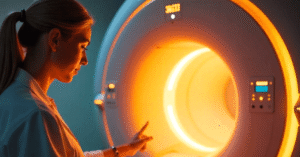Magnetic Resonance Imaging (MRI) has become one of the most essential tools in modern healthcare. For job seekers, healthcare employers, and professionals considering a career move, understanding a clear MRI tech job description is crucial. Whether you’re exploring new opportunities or drafting a hiring post, this guide breaks down responsibilities, qualifications, and real career insights.
What Does an MRI Tech Do?

An MRI technologist operates MRI scanners to create detailed images of the body that help physicians diagnose medical conditions. Beyond scanning, their role combines technical expertise, patient care, and safety compliance.
Core MRI Technologist Duties
-
Preparing patients for imaging procedures
-
Positioning patients and explaining the process clearly
-
Operating MRI equipment to capture high-quality images
-
Monitoring patient comfort and safety during scans
-
Collaborating with radiologists to review and analyze images
-
Maintaining imaging equipment and reporting issues
These MRI technician responsibilities highlight why the role demands both technical skills and empathy.
MRI Tech Job Description: Education, Certifications, and Qualifications
Every magnetic resonance imaging job description includes minimum education and certification requirements. Employers seek candidates who balance training with patient-centered skills.
MRI Technologist Qualifications
-
Education: Associate’s or bachelor’s degree in radiologic technology or MRI
-
Certification: ARRT (American Registry of Radiologic Technologists) or equivalent
-
Licensing: Required in most states
-
Skills Needed: Attention to detail, communication, problem-solving, and knowledge of safety protocols
For students or healthcare workers looking to advance, certifications in MRI are a direct pathway into this specialized role.
MRI Tech Role in Hospitals and Clinics

An MRI tech role in hospital settings goes beyond imaging. Technologists may assist emergency teams, handle critical cases, and adapt quickly to changing patient needs.
MRI Technologist Work Environment
-
Hospitals: Fast-paced, diverse caseloads
-
Diagnostic Centers: Scheduled appointments, steady workflow
-
Outpatient Clinics: Focused patient care, flexible hours
Work environments vary, but each setting requires adaptability and strong patient interaction.
Common Questions About the MRI Tech Job Description
What does an MRI tech do on a daily basis?
On a typical day, an MRI technologist reviews physician orders, prepares patients, conducts scans, and communicates findings with radiologists.
What are the key MRI job requirements?
Employers look for certified professionals with proven technical ability, patient care skills, and familiarity with MRI safety standards.
What’s the difference between a radiology technologist vs MRI tech?
Radiology technologists perform imaging using X-ray, CT, or other modalities, while MRI technologists specialize exclusively in magnetic resonance imaging.
What’s the MRI career outlook?

According to labor reports, MRI technologists are in high demand. Growth is driven by an aging population and expanded access to advanced imaging. Salaries are competitive, averaging $75,000–$90,000 annually depending on location and experience.
Writing an Effective MRI Tech Job Description for Employers
Healthcare recruiters often struggle to balance detail with clarity when posting roles. A strong MRI technologist job description for hospitals should include:
-
Clear job title (MRI Technologist / MRI Technician)
-
Summary of daily duties and responsibilities
-
Required education and certifications
-
Key qualifications and desired skills
-
Information about work environment and schedule
-
Career growth opportunities and benefits
Conclusion
An accurate MRI tech job description helps both employers and job seekers align expectations. For students and career changers, this path offers strong growth, stability, and opportunities to work with cutting-edge technology while making a difference in patient lives. For employers, a clear description ensures the right candidates are drawn to the role.
FAQ,s
What does an MRI tech do on a daily basis?
An MRI tech operates imaging equipment, prepares patients, conducts scans, and collaborates with radiologists to ensure accurate results.
What are the key MRI job requirements?
Employers require formal education, ARRT certification, licensing (in most states), and strong technical and communication skills.
What’s the difference between a radiology technologist vs MRI tech?
Radiology technologists use multiple imaging methods like X-ray and CT, while MRI techs specialize exclusively in magnetic resonance imaging.
What skills are most important for an MRI technician?
Attention to detail, patient care, problem-solving, and equipment handling are essential skills for MRI technicians.
How long does it take to become an MRI technologist?
Typically 2–4 years, depending on prior education and whether you pursue an associate’s, bachelor’s, or certification program.
What is the MRI career outlook and salary range?
The MRI career outlook is strong, with growing demand. Salaries average between $75,000–$90,000 annually, depending on location and experience.
Author Bio
Written by Humma Iltaf, a professional content writer with expertise in SEO-driven healthcare and business topics. Humma holds a degree in English Literature and has several years of experience creating content tailored for job seekers, professionals, and recruiters.

